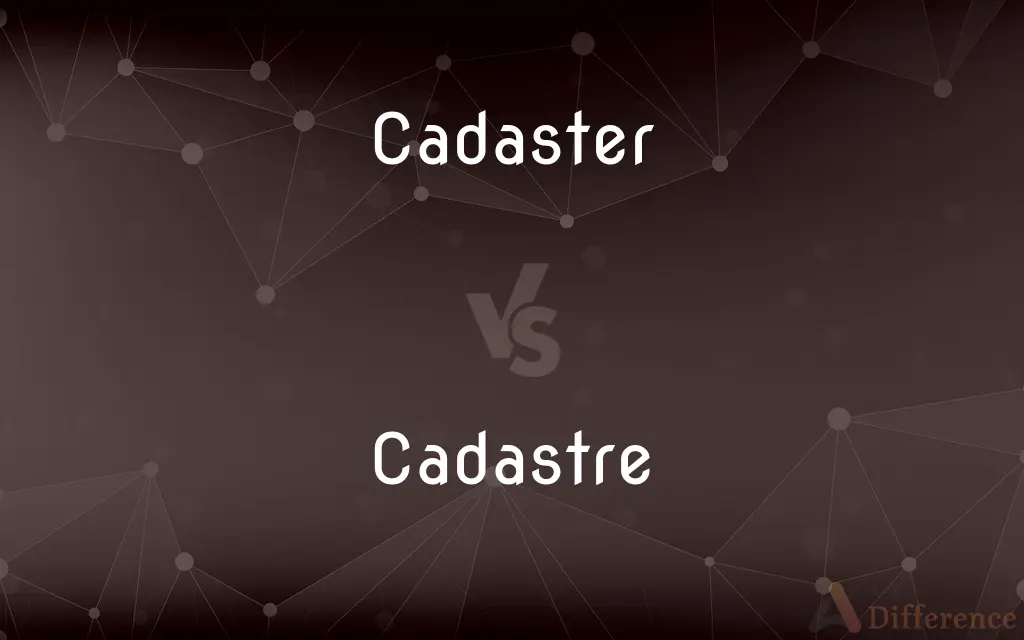Cadaster vs. Cadastre — What's the Difference?
Edited by Tayyaba Rehman — By Maham Liaqat — Updated on May 1, 2024
Cadaster and cadastre refer to the same concept—a public registry used to record details about property ownership and land parcels, differing only in spelling variations.

Difference Between Cadaster and Cadastre
Table of Contents
ADVERTISEMENT
Key Differences
Cadaster, commonly spelled as cadastre in many English-speaking countries, represents an official register of the size, value, and ownership of real estate used for taxation.
While "cadaster" is an alternative spelling predominantly found in some English-speaking contexts, "cadastre" is the more commonly used term globally and in international contexts. Both terms describe the same system that documents land and property details, essential for urban planning, land management, and tax assessment.
The choice between "cadaster" and "cadastre" may reflect regional language preferences or the influence of local legal terminology.
In countries where "cadastre" is used, the system is often integral to the government’s ability to manage public lands and resources effectively. Whereas, in places using "cadaster," the terminology may align more closely with specific historical or legal precedents that influence local property laws. Regardless of the spelling, both terms serve critical administrative functions and are crucial for ensuring the clarity of land ownership and boundaries.
Comparison Chart
Definition
A public register recording property ownership and land details.
Identical to cadaster; records details about property and land parcels.
ADVERTISEMENT
Common Usage
Used in some English-speaking regions.
More widely used internationally.
Function
Essential for tax assessment, urban planning, and land management.
Identical to cadaster; used for similar administrative purposes.
Spelling Preference
Preferred in specific legal or historical contexts.
More globally recognized spelling.
Role in Governance
Critical for managing property laws and ownership clarity.
Same as cadaster, pivotal in managing land and public resources.
Compare with Definitions
Cadaster
Used for legal documentation and taxation purposes.
Accurate cadaster records are crucial for calculating property taxes.
Cadastre
Supports legal compliance and enforcement in real estate.
Updates to the cadastre were mandated after the new zoning laws passed.
Cadaster
Ensures transparency in real estate transactions.
Before buying the land, they checked the cadaster to verify ownership details.
Cadastre
Facilitates clear land title and ownership transparency.
The cadastre was crucial in resolving the border dispute between the two estates.
Cadaster
Influences local property laws and regulations.
The reform in property law required updates to the cadaster entries.
Cadastre
An official register of property ownership, boundaries, and values.
The cadastre showed that the farm was smaller than the seller had advertised.
Cadaster
A public registry that records the details of property ownership and land parcels.
The local government updated the cadaster to reflect recent changes in land ownership.
Cadastre
Utilized in planning and development to manage space efficiently.
The city's expansion plans were based on maps and data from the cadastre.
Cadaster
Helps in urban and regional planning by providing precise property boundaries.
Planners used the cadaster to avoid disputes during the new highway construction.
Cadastre
Integral to governmental land management and taxation.
The government relied on cadastre data to distribute agricultural subsidies.
Cadaster
A public register showing details of ownership of the real property in a district, including boundaries and tax assessments.
Cadastre
A cadastral map (shortened to cadastre or cadaster) is a comprehensive land recording of the real estate or real property's metes-and-bounds of a country.In most countries, legal systems have developed around the original administrative systems and use the cadastre to define the dimensions and location of land parcels described in legal documentation. A land parcel or cadastral parcel is defined as "a continuous area, or more appropriately volume, that is identified by a unique set of homogeneous property rights".In the United States, Cadastral Survey within the Bureau of Land Management (BLM) maintains records of all public lands.
Cadaster
Alternative spelling of cadastre
Cadastre
A public register showing details of ownership of the real property in a district, including boundaries and tax assessments.
Cadaster
Same as cadastre.
Cadastre
(cartography) A public survey of land, originally for the purpose of taxation and to create an official register of land ownership.
Cadaster
A public register showing the details of ownership and value of land; made for the purpose of taxation
Cadastre
A register of such surveys, showing details of ownership and value.
Cadastre
An official statement of the quantity and value of real estate for the purpose of apportioning the taxes payable on such property; a public register showing the details of ownership and value of land.
Cadastre
A public register showing the details of ownership and value of land; made for the purpose of taxation
Common Curiosities
How do cadaster and cadastre aid urban planning?
Both provide essential data on land use, ownership, and boundaries, which are crucial for effective planning and development.
What is the purpose of a cadaster?
A cadaster serves to document land ownership, boundaries, and property values for taxation and legal purposes.
What role does a cadastre play in tax assessment?
It provides the necessary property details to accurately assess and levy property taxes.
Is there a difference between cadaster and cadastre?
No, there is no difference in function; the variation is purely in spelling.
Who manages the cadastre in most countries?
Typically, a governmental agency or a department dedicated to land resources manages the cadastre.
Which countries use the term cadastre?
Cadastre is commonly used in Europe, Canada, and international contexts.
What kind of information can you find in a cadastre?
A cadastre includes details about land parcels, ownership, precise measurements, and the value of properties.
How often is a cadastre updated?
Update frequency depends on local regulations but generally occurs when there are changes in land ownership or usage.
What makes the cadastre essential for real estate transactions?
It ensures that all parties have access to accurate and official property details, reducing the risk of fraud.
Why might one prefer to use "cadaster" over "cadastre"?
The preference usually depends on regional language norms or historical legal terminology.
Can discrepancies in cadastre entries lead to legal disputes?
Yes, inaccuracies in cadastre entries can lead to disputes over land ownership and boundaries.
How does a cadastre impact property values?
It records and reflects changes in property values based on market dynamics and land usage changes.
What challenges are associated with maintaining a cadastre?
Maintaining accuracy, handling large volumes of data, and updating records in a timely manner are major challenges.
Are cadaster and cadastre databases publicly accessible?
Accessibility varies by country, but generally, these records are available to the public for transparency.
Is digitalization affecting how cadastres are managed?
Yes, digitalization has significantly improved the efficiency, accessibility, and accuracy of cadastre management.
Share Your Discovery

Previous Comparison
Snipper vs. Sniper
Next Comparison
Barrel vs. TierceAuthor Spotlight
Written by
Maham LiaqatEdited by
Tayyaba RehmanTayyaba Rehman is a distinguished writer, currently serving as a primary contributor to askdifference.com. As a researcher in semantics and etymology, Tayyaba's passion for the complexity of languages and their distinctions has found a perfect home on the platform. Tayyaba delves into the intricacies of language, distinguishing between commonly confused words and phrases, thereby providing clarity for readers worldwide.
















































